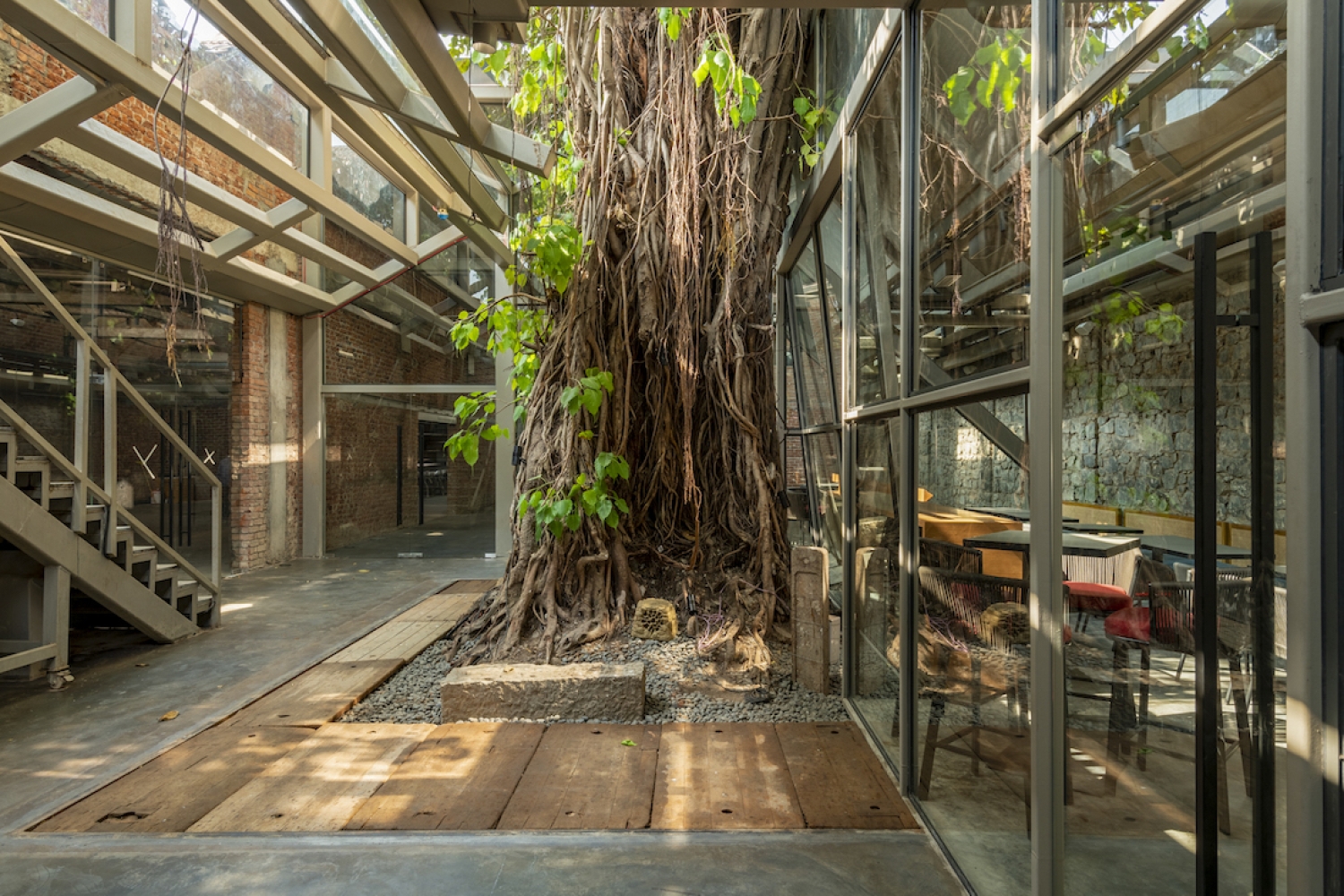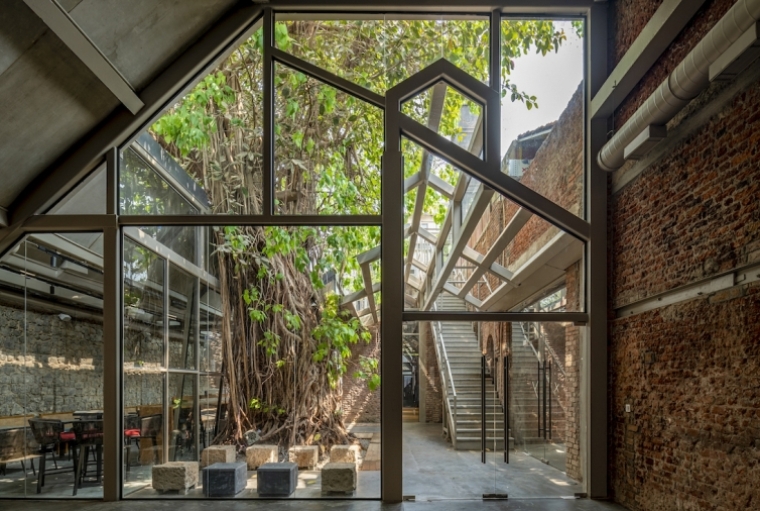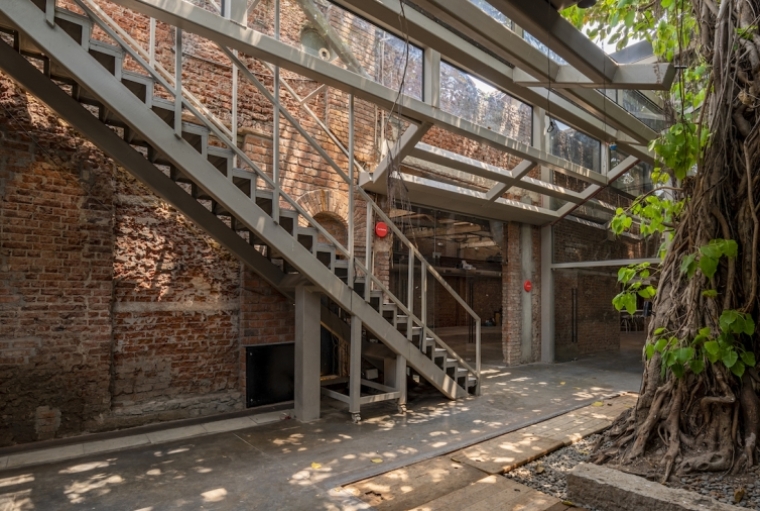
Banyan Tree Cafe

Banyan Tree Cafe
Before the dawn of architecture, man had to understand his relationship with the environment, local resources, topography and climate before building anything. Kamal and Arjun Malik, a father-son duo at the helm of Malik Architecture, are trying to revolutionise how we look at architecture by taking inspiration from the pre-architecture age, where people built for themselves without being able to transport material across continents, or using electricity. Take their project in Rajasthan for example — a basement plus three-level house, done only in dual pro stone. There is no steel, concrete, paint, plaster and fall-ceiling. They worked with one material, a set of masons, all available forty-five minutes away from the site.
Their most recent project is IFBE — a new experimental architecture and art space in a re-fashioned and conserved ice factory. Situated in Mumbai’s oldest dockyards of Ballard Estate, IFBE has been revamped into a space that blends its past with the future. The space houses exhibition spaces, a performance venue, The Banyan Tree Cafe, and Native Bombay, a restaurant that is set to open soon. The space is fluid, agile and changes depending on the nature of the cultural affair. “The acronym IFBE was coined to pay homage to the location’s rich heritage. It also alludes to the independent words ‘IF’, suggestive of endless possibilities and a sense of wonder, and ‘BE,’ a counterweight that provides balance and (re)solutions. IFBE represents a platform where existing behaviours and perceptions are challenged, where open dialogue moves from the currently trending to the truly relevant, where architecture, design and the arts finally move beyond their own aesthetically bound definitions to becoming instruments that drive holistic and enduring change.”
Do you remember your first meaningful project?
One of the first meaningful things that came my way was when we did a home for a sister group of the Times of India group, the Jains. And we did a farmhouse for them in Delhi. There was an opportunity to exhibit a little bit of creativity, which you normally don’t get at that age or juncture in your life. I think that it was there where I began to understand how to work in a sustainable manner, which has been the core of the practice over the last four and a half decades. When I say sustainable, I always go a little deeper than looking at issues like leads and ratings because they’re just figures. It is more important to understand life itself — which side the sun rises, what is summer, winter? What is the wind movement? What are the local materials? How people lived traditionally, when they had no electricity and yet they survived so well?

Cathedral
When you first set foot in the ice factory for IFBE, what were the key elements of the space that you retained?
Two salient points. First, that drew us to this place, was how natural light filtered into it. Most events are held in hotels today, which are completely hidden. There was a very natural way in which light was filtering through into this place. Second point was the courtyard and the banyan tree. The Banyan Tree is really symbolic. It’s a metaphor for transformation, for change, which we feel is badly required. My father started off his office in Nariman Point and then moved to Ballard Estate about twenty-one years ago. And Ballard Estate has been a topic of research from the design/architecture point of view for many years. It’s one of the last commercially functioning heritage precincts in the country. And how do you project its history into the future? Now we’ve seen all our friends banging their heads against walls for decades and getting nowhere because the moment you have to deal with the government for projects, there are wheels within wheels. But when this place came up, we thought that it is really possible to put our money where our mouth is, take up this space and see if we can actually create a certain archetype.
How are you going to keep the place culturally inclusive?
It’s challenging because normally what happens at most venues, whether it be for art or music, is that they are very neutral. So it becomes all about the content. Like with a museum, for example, there’s this discussion going on on whether it should be pure white boxes or can they have a different design aesthetic. Now, IFBE is a space that can hold prefigured content. It challenges people to interpret the space in context. You can do different installations in here. I would love to come in here and do a site specific collaboration with an artist, or even design a multi-architecture exhibition. But I’m staying away from it right now to let people come in and interpret the space on their own.

Courtyard
What, according to you, is the duty of design in our world?
Balance balance balance. Our resources are being chewed up! We are no longer living in a vacuum and the context is far more complicated and diverse. Design has to be plugged into sustainability. We are working mostly in the private domain, for clients who have offices, homes, and most of them tend to buy into this idea, but not everyone is interested in philanthropy and charity. So you’re dealing with capitalism and personalities or individual organisations who have their own ideas, their own needs, their own emergencies. And within that, we are trying to retain the sanctity and achieve the balance that we spoke about. Some projects are fairly fundamental, but it’s when things start to expand, that’s where the real pressure starts to try to stop and limit the damage, and strike a balance between man and nature.
How would you define good design?
Striking a balance and using the resources. Everybody’s desperate for identity. This word, identity, has caused an identity crisis in our profession worldwide. Why can’t we be comfortable with being many things instead of being one thing. And especially with the way that information is now being disseminated in the public domain. Earlier there was no social media. There used to be a time when you either experienced a space through design or you read about it. The flow of information was slower. It was more contained. It was more curated. Now everything’s just out there. So everybody is fighting to be heard, to be seen. And therefore, people, I think, have fundamentally forgotten what design is and its purpose.
They are just concerned with the visuals and communication of design. In essence, they are no longer concerned with reality. They are concerned with the representation of realities. Not with content, but the illusions of content, because that narrative is so easy to build and communicate across ten pictures. They’re no longer burdened with the actual sustainability or authenticity or other constraints of reality. They’ve constructed a new reality, which is basically made-up of one hundred and forty characters and a few thumbnails. We’re, however, dealing with the core idea of design as something that has to have meaning, that has to be sustainable.
This article is an all exclusive from our September EZ. To read more such articles, follow the link here.
Text Hasika Lohani Mehtani
Date 30-09-2022